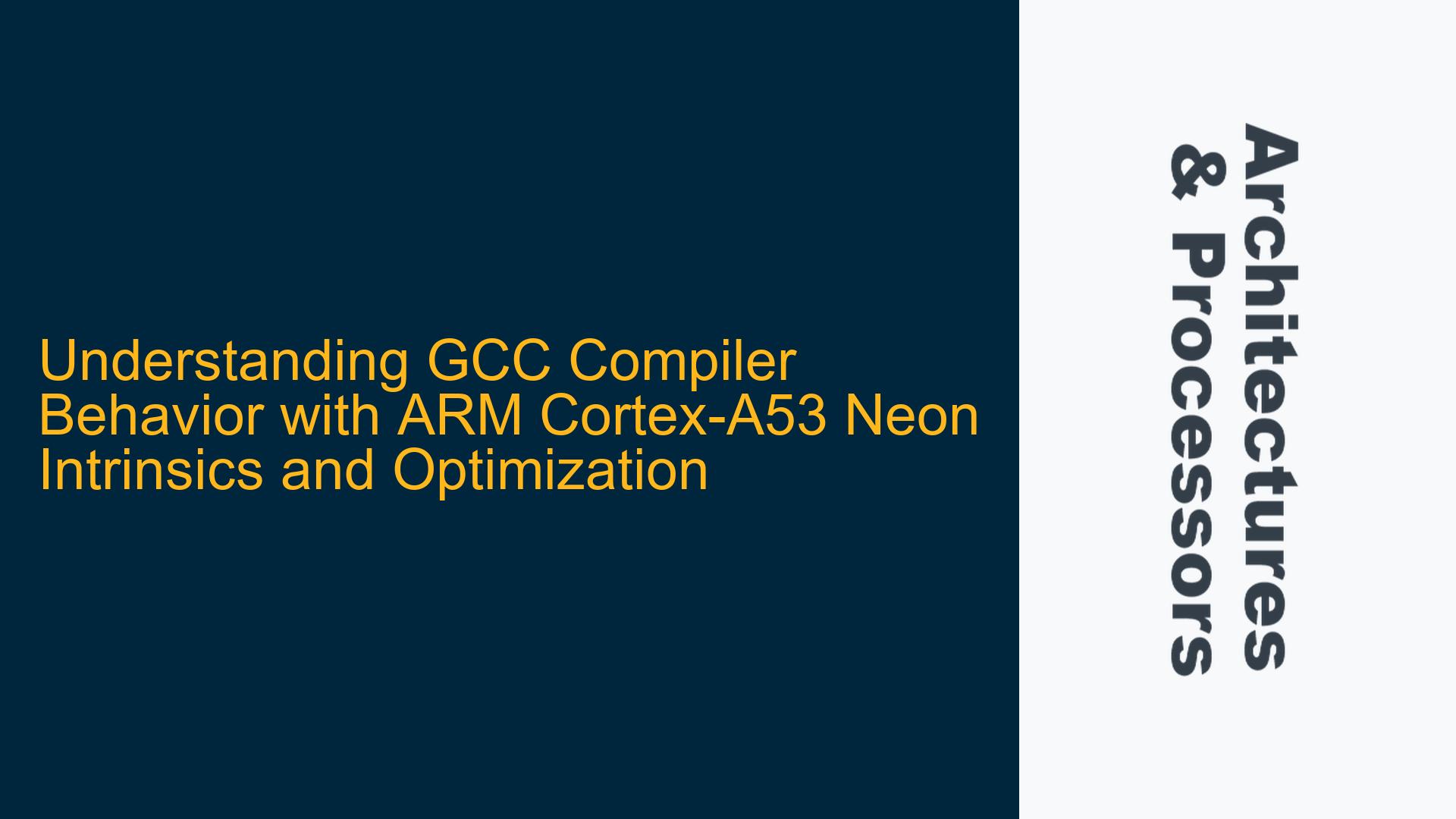ARM Cortex-A53 Neon Intrinsics Performance Issues at O3 Optimization
Issue Overview: Neon Intrinsics Code Performance and Compiler Behavior
The core issue revolves around the performance and behavior of Neon intrinsics code when compiled with GCC (aarch64-none-elf-gcc) at the highest optimization level (-O3) for the ARM Cortex-A53 processor. The user is working on a bare-metal application and has implemented a function to multiply two 16-element floating-point arrays using Neon intrinsics. The function is designed to load 4-element chunks of data into Neon registers, perform vectorized multiplication, and store the results back into memory. However, the user observes no significant performance improvement compared to a scalar C implementation. Additionally, the user is confused by the disassembly output, particularly the presence of intrinsic function bodies (e.g., vst1q_f32) in the assembly code and the compiler’s handling of Neon instructions.
The user also raises concerns about the compiler’s recognition of specific flags, such as -mfpu=neon and -mfloat-abi=hard, which are not being accepted by the compiler. Despite this, the disassembly shows vector instructions, suggesting that the code is indeed running on the Neon engine. The user seeks clarification on how to ensure the compiler uses hardware linkages and optimize the code further.
Possible Causes: Compiler Optimization, Intrinsic Handling, and Flag Misconfiguration
-
Compiler Optimization and Intrinsic Handling:
- At
-O3, the GCC compiler aggressively optimizes code, including inlining functions, reordering instructions, and eliminating redundant operations. This can lead to disassembly that appears fragmented or difficult to follow, especially with intrinsics. The presence of intrinsic function bodies in the disassembly is likely due to the compiler inlining these functions for performance reasons. - The use of
vmlaq_f32(multiply-accumulate) instead ofvmulq_f32(multiply) in the code is a potential source of inefficiency. Since the accumulator (C0,C1, etc.) is initialized to zero, the accumulate operation is redundant. This could result in unnecessary instructions and reduced performance.
- At
-
Misconfigured Compiler Flags:
- The user reports that the compiler does not recognize
-mfpu=neonand-mfloat-abi=hard. This could be due to the compiler version or target architecture configuration. For AArch64, the-mfpuflag is not required because Neon is part of the base architecture. However, the-mfloat-abiflag is crucial for specifying floating-point calling conventions. If the compiler does not recognize these flags, it may default to a soft-float ABI, which could impact performance.
- The user reports that the compiler does not recognize
-
Memory Access Patterns and Alignment:
- The code loads and stores data in 4-element chunks using
vld1q_f32andvst1q_f32. If the input arrays (A,B, andC) are not aligned to 16-byte boundaries, this could result in suboptimal memory access patterns and performance degradation. The Cortex-A53’s Neon engine performs best when data is aligned and accessed sequentially.
- The code loads and stores data in 4-element chunks using
-
Compiler-Generated Code Quality:
- The disassembly shows that the compiler generates
fmla(floating-point multiply-accumulate) instructions, which are correct but may not be optimal for the specific use case. The compiler’s choice of instructions and register allocation can significantly impact performance, especially in tight loops.
- The disassembly shows that the compiler generates
Troubleshooting Steps, Solutions & Fixes: Optimizing Neon Intrinsics Code and Compiler Configuration
-
Review and Refactor Intrinsics Usage:
- Replace
vmlaq_f32withvmulq_f32since the accumulator is initialized to zero. This eliminates redundant operations and simplifies the code. - Ensure that the input arrays (
A,B, andC) are aligned to 16-byte boundaries. Use__attribute__((aligned(16)))to enforce alignment. - Example refactored code:
void multiply_4x4_neon(float *A, float *B, float *C) { float32x4_t A0 = vld1q_f32(A); float32x4_t B0 = vld1q_f32(B); float32x4_t C0 = vmulq_f32(A0, B0); vst1q_f32(C, C0); float32x4_t A1 = vld1q_f32(A + 4); float32x4_t B1 = vld1q_f32(B + 4); float32x4_t C1 = vmulq_f32(A1, B1); vst1q_f32(C + 4, C1); float32x4_t A2 = vld1q_f32(A + 8); float32x4_t B2 = vld1q_f32(B + 8); float32x4_t C2 = vmulq_f32(A2, B2); vst1q_f32(C + 8, C2); float32x4_t A3 = vld1q_f32(A + 12); float32x4_t B3 = vld1q_f32(B + 12); float32x4_t C3 = vmulq_f32(A3, B3); vst1q_f32(C + 12, C3); }
- Replace
-
Verify Compiler Flags and Configuration:
- Ensure that the compiler is configured to target the ARM Cortex-A53 architecture. Use the
-mcpu=cortex-a53flag to enable architecture-specific optimizations. - For AArch64, the
-mfpu=neonflag is not required, but ensure that the compiler is using the hard-float ABI. Use-mfloat-abi=hardif supported by the compiler. If the flag is not recognized, check the compiler documentation or update to a newer version.
- Ensure that the compiler is configured to target the ARM Cortex-A53 architecture. Use the
-
Analyze Disassembly for Optimization Opportunities:
- Use tools like
objdumporgdbto analyze the disassembly and identify potential bottlenecks. Look for inefficient instruction sequences, such as redundant loads/stores or suboptimal register usage. - Example command to generate disassembly:
aarch64-none-elf-objdump -d <binary> > disassembly.txt
- Use tools like
-
Benchmark and Profile the Code:
- Use performance counters or profiling tools to measure the execution time of the Neon intrinsics code and compare it to the scalar implementation. Identify hotspots and optimize further if necessary.
- Example profiling command using
perf:perf stat ./your_program
-
Experiment with Compiler-Specific Pragmas and Attributes:
- Use pragmas like
#pragma GCC unrollto manually control loop unrolling or__attribute__((optimize("O3")))to apply specific optimizations to individual functions. - Example:
void multiply_4x4_neon(float *A, float *B, float *C) __attribute__((optimize("O3")));
- Use pragmas like
-
Consider Assembly-Level Optimization:
- If the compiler-generated code is still suboptimal, consider writing critical sections in inline assembly. This allows fine-grained control over instruction selection and scheduling.
- Example inline assembly for Neon multiplication:
asm volatile ( "ld1 {v0.4s}, [%[A]]\n" "ld1 {v1.4s}, [%[B]]\n" "fmul v2.4s, v0.4s, v1.4s\n" "st1 {v2.4s}, [%[C]]\n" : : [A] "r" (A), [B] "r" (B), [C] "r" (C) : "v0", "v1", "v2", "memory" );
By following these steps, the user can address the performance issues with Neon intrinsics, ensure proper compiler configuration, and gain a deeper understanding of the generated assembly code. This approach will help optimize the code for the ARM Cortex-A53 processor and leverage the full potential of the Neon engine.






